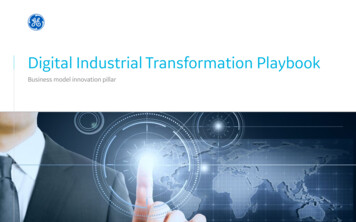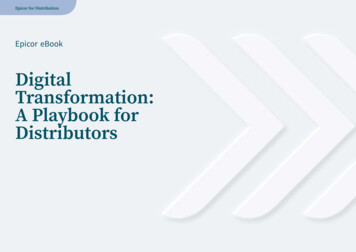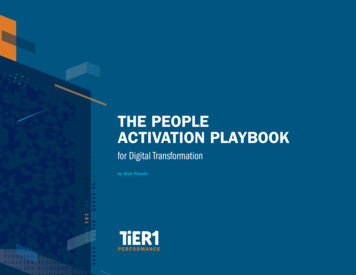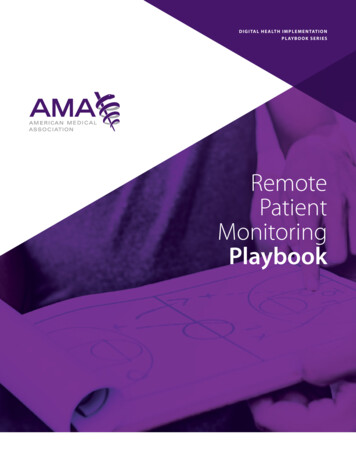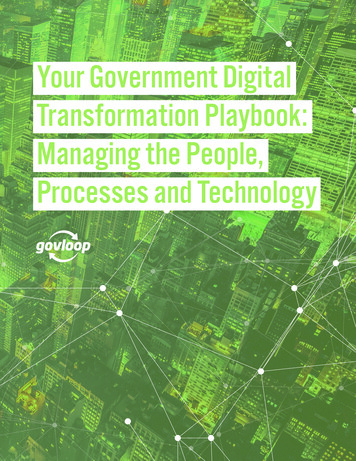
Transcription
Your Government DigitalTransformation Playbook:Managing the People,Processes and Technology
Table of Contents345789101112131516Executive SummaryThe Impetus for Going DigitalDigital Trends in GovernmentSeizing the Next Generation of Government Content Management#1 Managing the People of Digital TransformationHawaii CIO Shares the People Side of Digital Transformation Strategy6 Plays to Manage the People Aspect of Your Digital Transformation#2 Managing the Processes of Digital TransformationNASA Program Manager Shares the Process Sideof Digital Transformation6 Plays to Manage the Processes of Your Digital TransformationAligning IT to Mission for Strategic TransformationDigital Transformation: How to Take IT Infrastructureto the Next Level1819#3 Managing the Technologies of Digital Transformation2021226 Plays to Manage the Technologies of Your Digital TransformationMinnesota IT Leader Shares the Technology Side of DigitalTransformation Strategy23252628#4 Managing the End Users of Digital TransformationVeterans Health Administration Delivers TelehealthThrough the Power of End Users6 Plays to Manage the End Users of Digital TransformationTransforming Networks to Meet Government’s Mission NeedsAccelerating Digital Transformation in the Ocean StateConclusion
Executive SummaryDigital transformation is the next big thing ingovernment. Digital transformation can be defined as away to enhance employee functions or citizen servicesso that users can easily access them from anywhere, atany time and with any device. Whether it’s analytics orthe Internet of Things or IT modernization, there aremany ways your agency can do digital.Digital transformation is expected to yieldmajor savings for government, such as reducingprocurement costs by up to 24 percent.But digital transformation is more than keeping upwith the latest technology trends and gadgets. Forgovernment, it requires serious cultural change withinorganizations and strong leadership to help workforcesadapt to new processes and technologies. In fact, ina recent GovLoop poll, 36 percent of our communitycited change management as the most challengingaspect of digital transformation, followed closely byadjusting to new technologies (28 percent).Whether you’re the senior executive leading the chargeWhat aspectof digitaltransformationis mostchallenging foryour agency?on digital transformation, the technology expert puttingthe digital tools together or the end user the changesaffect, GovLoop’s latest guide is for you.Use this playbook to help you manage and navigatethe people, processes and technology involved indigital transformation. Specifically, this guide willprovide insight from government leaders who’vebeen there and case studies showcasing successfuldigital transformation to help you identify waysto help your organization’s workers adapt to newtechnologies and processes.When done right, digital transformation can yieldtremendous results for government, such as improvedcustomer service, cost savings and a more empoweredworkforce. But to achieve success, you must considerall the components of digital transformation: thepeople, processes and technologies.36%Change management30%Procuring the right technologies28%Adjusting to new technologiesA Govloop GuideForming the IT teams6%3
The Impetusfor Going DigitalThe Latest in LegislationOMB’s User Guide to the MGT ActFinal White HouseIT Modernization ReportThe Modernizing Government Technology (MGT) Actwas signed into law Dec. 13, 2017, as part of the 2018National Defense Authorization Act. The MGT Act createsa centralized modernization fund of 250 million over twoyears dedicated to assisting government agencies with themonetary aspect of IT modernization, allowing agencies tomove forward with digital transformation. The legislationaims to help agencies overcome the high upfront costsof purchasing new systems and software. Although thepresident’s fiscal 2019 budget includes only 210 millionfor each year the IT modernization fund provides, MGTwill have a significant impact on government digitaltransformation efforts.With increasing citizen expectations and pressure toupgrade technology, federal agencies have more impetus tomodernize their systems as part of digital transformation.Agencies not only experience monetary barriers to digitaltransformation, however, but also legal obstructionsbecause of outdated federal technology legislation.The Office of Management and Budget (OMB) has releaseda user guide for the act that assists agencies with projectproposals and managing individualized agency funds. OMBwill conduct regular reviews of the projects to determinewhether to continue or withhold funding. Additionally,because agencies are expected to reimburse the fund, OMBwill offer guidance for those that are likely unable to repaythe money, and it will serve as a mediator should an agencyfail to reimburse the fund entirely.The modern systems would allow agencies to implementcybersecurity measures that are compatible with legacysoftware and would lead to increased collaboration andstreamlining of government services. How agencieschoose to move forward with digital transformation willbe individualized, but the legislation, coupled with OMBguidance, will make IT modernization possible for agenciesthat could not afford the updates previously.4The White House’s American Technology Councilreleased the final “Report to the President on Federal ITModernization” on Dec. 13, 2017. The report highlightsshared services and network modernization andconsolidation as keys to achieving federal IT modernization,and described the legislative changes that will facilitatedigital transformation at agencies.The report suggests changes that should be made toexisting federal IT policies to assist agencies in adoptingshared services and network consolidation. It also statesthat current legislation should be “rapidly and iterativelyupdated to eliminate barriers to cloud adoption,” soagencies can migrate information and services tocommercial clouds. It also suggests that the federalgovernment address “resource allocation and disparateagency interpretations of statutes and guidance” as otherhurdles to adoption of shared services.With the elimination of these legislative obstacles, agenciescould adopt shared services that would reduce costs andincrease efficiency by streamlining internal governmentservices such as IT management and HR into a centralizedservice provider. Network modernization could be alignedwith cloud migration, which would update high-risk, highvalue IT assets to improve security and the consolidationand acquisition of network services.Your Government Digital Transformation Playbook
6 Digital Trends in Government1 IoT.IoT integrates sensors and actuators into aphysical object that is connected to a network, therebyimproving communication between the digital andphysical worlds. IoT can be used for anything in thepublic sector, from transforming transportation toworkplace automation. One of the most commonlycited uses of IoT is to monitor road traffic, but it canalso improve the security of federal buildings or assistwith public safety by detecting an impending naturaldisaster.2 Data Analytics.The government is knownfor high-volume and varying data sets, which aretough to extract important information from withoutsophisticated, automated processes and algorithms.Data analytics can help with data input and observingtrends that can improve operations and performance.3Blockchain. Blockchain technology is most4 Mobility.The public sector is increasing mobilityby streamlining government services into mobileapplications. Increased mobility of government serviceswill allow citizens to access information and servicesfaster by limiting paperwork and wait times. Mobilitywill also improve communication between the publicsector and citizens who rely on smartphones as theironly technology.5 IT modernization.IT modernizationencapsulates many of the trends cited here but isa process defined as the continuous evolution ofan agency’s current infrastructure, software andapplications. Modernization allows agencies tosave costs by reducing the amount they spend onmaintaining legacy systems.6 Automation.simply defined as a list of records, or blocks, that arelinked together through cryptography. Because eachblock contains a record of the previous transaction,including timestamps, government can use blockchaintechnology to improve collaboration within agenciesand teams. The information recorded on each blockcan be distributed, but not modified, thereforeincreasing cybersecurity.Automation is the process ofperforming tasks such as data input, analysis andscanning with little to no human assistance. Someagencies are turning to artificial intelligence toautomate routine tasks. Using automation, agenciescould cut costs by spending less on hiring individualsto perform tedious data input processes that could beperformed with algorithms. Automation also allowsIT employees to home in on important cybersecurityprocedures by freeing up time they would usuallydedicate to manual procedures.How to Use This GuideIn the following pages are four sections highlighting the key agents of digital transformation within anorganization. These four sections — managing people, managing processes, managing technologies andmanaging end users — are catered, respectively, to: Senior executives (Managing the people and change management aspect of digital transformation) Program managers (Managing the processes and organizational aspect of digital transformation) IT leaders (Managing the technologies and tools aspect of digital transformation) End users (Managing the changes that can impact you if you’re any other employee within an organizationundergoing digital transformation)Each section will include tips to navigate your unique challenges within digital transformation, an interviewfrom leaders in your arena who have faced similar challenges and six plays or best practices to help bringthose action items to life.A Govloop Guide5
www.nuxeo.com. A AA6AYour Government Digital Transformation PlaybookA
Seizing the Next Generation ofGovernment Content ManagementAn Interview with Bobby Hangliter, Director of Federal Sales, and Lisa Marcus, Vice President of Public Sector, NuxeoThe creation of digital content is fundamentally changing thebusiness of government. Whether you work for a local lawenforcement agency or a large federal agency, chances are you’reno longer simply sorting documents in physical filing cabinets.Government content now comes in a wide variety of digitalformats ranging from photos to satellite imagery to surveillancevideo and social media.“The reality is that enterprise content will reside in multiplerepositories and will need flexible, centralized management andaccess – no matter where it resides,” said Hangliter. A moderncontent services platform can integrate and aggregate contentacross systems and replace outdated, duplicative applications witha single platform that can manage all content types and supportmultiple content-driven applications like case management andrecords management.So, how does government begin to effectively manage all of thisnew, unstructured digital content? And how can agencies ensurethey can find and use it when they need it?So, what are the core platform features agencies should look for ina modern Content Services Platform?The answer is by implementing a modern Content ServicesPlatform. According to a recent Gartner report, content servicesplatforms (CSP) are the next stage of enterprise contentmanagement (ECM), representing a shift from self-containedsystems to open repositories and services.Modern Architecture – Open Source architecture helps delivercontent-driven applications and services with massive scalabilityat a fraction of the cost of legacy ECM systems – and offers theflexibility to continually innovate by easily making changes toapplications to meet the changing needs of the business.In an interview with GovLoop, Bobby Hangliter, Director of FederalSales, and Lisa Marcus, Vice President of Public Sector, at Nuxeo,shared why a next-generation content services platform is criticalto digital transformation and what it should look like.Manage all Content Types – Traditional documents (MS Office,PDF) and digital assets like email and complex rich media (Audio,video, geospatial, social) – all in a single system.A modern content services platform combines the reality ofwhat is happening in the digital enterprise with future-forwardtechnology to enable agencies to strategically solve contentrelated problems.“In dealing with the volume and variety of data and with agenciesmoving to the cloud, government needs more flexible and scalableplatforms,” Hangliter said. “They need future-forward technologiesthat go beyond simple storage and can help them modernize theirbusiness and mission functions.”When agencies were managing mostly PDF files and otherstandard text inputs, ECM systems were good enough. Butwith the growing diversity and volume of data in the digital age,coupled with the expectations from employees and citizens, thesesystems are not able to keep up. They store content in a waythat makes it difficult to efficiently manage and quickly accessinformation. “Agencies suffer from having too many disparatecontent management systems,” Marcus said. “Many of whichare outdated and lack the modern capability to properly tag thecontent for searchability. And because they are siloed systems,there is a lot of duplication.”For example, agencies may have separate systems for documentmanagement, records management, photos and videos. Theproblem with these disparate systems is not only do they createstovepipes that prevent employees from finding the rightinformation in a timely manner, they also impede the process ofdelivering citizen services.Massive Scalability – The ability to leverage leading-edge filestorage and database technologies - including NoSQL means thesystem can scale to manage massive amounts of content.Integration Capability – The ability to integrate with existingsystems through connectors and API’s enables agencies to managecontent in place and allows business users the option to workwithin the systems they are familiar with – which eliminates datasilos and improves efficiency.Advanced Metadata Model – Using machine-learningalgorithms, artificial intelligence (AI) and machine learning (ML)tools to tag content is a critical component for searchability.Faster Time to Value – A platform that is operational fromday one by delivering out-of-the-box connectors and a varietyof content services, plug-ins, productivity applications, andautomation and workflow capabilities - for immediate adoptionand fast deployment.“At Nuxeo we work with organizations to evaluate where a contentservices platform can be of real value to reduce costs and improveefficiencies,” said Marcus. “We then work with the business andIT teams to develop a migration strategy for content systems andapplications. We determine the right onramps, where they cangain value quickly, and then build out from there,” Marcus said.As digital transformation initiatives gain momentum and newtechnology areas like big data expand, agencies can use amodern content services platform to help accelerate digitaltransformation, improve operational efficiencies and unlock theunlimited value of their information.A Govloop Guide7
#1Managing the People ofDigital TransformationRead this play if you are: an executive leader, including chief information officer(CIO), chief information security officer (CISO) or any position that requires you tooversee an entire agency or department.Like it or not, digital transformation will fundamentallychange your agency’s mission-critical processes andoperations. If done right, digital transformation changeshow your agency works, thinks and addresses challengesfor the better. But to implement those fundamentalchanges, you must consider the most-affected component:your agency’s people. In fact, managing the people aspectof digital transformation is just as important as thetechnologies, processes and infrastructure involved.That’s why it’s your job as a leader to set the tone from topto bottom and foster a workplace culture ripe for change. Itis also imperative that you seek the right talent to drive thesuccesses digital transformation can yield.The most difficult part of a successful digital transformationcan be the cultural piece. You may feel obligated tooverhaul your entire agency, but sometimes only softerchanges are needed, such as language or employeemotivation, rather than drastic ones such as talent,organizational structure and operating models.The People Powerof Digital TransformationHere are a few key reasons why top-level government leaders like you needto focus on the people part of your digital transformation efforts.84%79%40%of CEOs are involved andcommitted to transformationalchange, while only 45 percent offrontline employees are engagedof transformation initiativesare completed when seniorleaders communicate withemployees across all levels ofthe organizationof CIOs will use vision- andmission-driven leadership toinspire and empower theirorganizations to createdigital transformationcapabilities by 2020(Source: McKinsey Survey 2017)(Source: McKinsey Survey 2015)(Source: 2017 IDC Predictions forDigital Transformation and CIOs)8Your Government Digital Transformation Playbook
Hawaii CIO Shares the People Side ofDigital Transformation StrategyHawaii CIO Todd Nacapuy’s mission for his organizationwas simple: modernize the state of Hawaii. In an interviewwith GovLoop, Nacapuy shared his strategy to achievedigital transformation through IT modernization in theAloha State.Digital goal: Improving digital literacy among the state’s800 IT employees. Nacapuy’s approach also emphasizedhaving a positive impact on Hawaii’s non-IT workforce ofabout 80,000.“The biggest thing we have in our state government is whatI call digital literacy,” Nacapuy said. “We have what we callfour generations of workers in our workforce. And we don’tclassify a generation of workers by age; we classify them bywhat technology was in place when they first started here inthe state.”“When you think about the different generations ofworkers that we have and what technology was in placewhen they started, you’re able to communicate to thoseworkers,” he said. “The four generations are mainframe,PC, laptop and mobile. How we communicate to the fourgenerations is very important. In the modern age and inthe digital age, a lot of people just want communications assimple as possible.”Advice to senior executives: Nacapuy recommends thatCIOs study up on their developers and technologies. “I’ma firm believer that CIOs need to be technical and that amajority of failed projects and failed implementations isbecause a lot of our modern-day CIOs are not technical.”To build technical skills, Nacapuy recommends followingspecific technologists. “I’m not talking to salespeople, I’m nottalking to sales engineers, I’m actually following developers,”he said. “I’m following their technologists that are within thecompany and the blogs that they’re publishing.”of times in the IT world, we have guys that have egos thatthink they know the most about a specific technology. Buthaving that background and that mindset teaches you tocheck your ego at the door.“Another thing that jiu-jitsu teaches you is when to ask forhelp. And we do that by tapping. So, if someone has you in aspecific hold, your only way out is to tap, to say, ‘Hey, you gotme. I give up. I tap. I need your help. Teach me how you gotthere.’ Same thing in our IT world . A lot of times we’ll spendhours and hours and hours trying to solve a problem insteadof picking up the phone and calling someone.“And the third thing that jiu-jitsu teaches us — one of thecardinal rules of jiu-jitsu — is to never hurt your sparringpartner. Once you hurt your sparring partner, no one’s goingto want to spar with you. In the IT world, it’s the same thing.We’ve got to learn to work as teams, we’ve got to learn notto hurt each other, and we have to be collaborative. I look forpeople that have those types of mindsets, and jiu-jitsu hastaught me to look for those things.”“In the modernage and in thedigital age, a lot ofpeople just wantcommunications assimple as possible”Todd Nacapuy, CIO, HawaiiIn addition to brushing up on technology knowledge andskills, Nacapuy said having the right mindset is key. He drawson jiu-jitsu to help in his IT approach. “Jiu-jitsu teaches adifferent mindset that carries well into the IT world. Oneof the first things that we do is bow before stepping on themat. And you bow to leave your ego at the door. And a lotA Govloop Guide9
6Plays to Managethe Peopleof Digital Transformation1 Tune into your organization.To helpcreate change, you need to establish credibility. Startby listening. Forge relationships with all stakeholdersinvolved. Then, go into listening mode by having oneon-ones with all employees (tech and non-tech). Seekfeedback on what technologies are working and whichare not. Go one step beyond attaining employees’requirements and gain a sense of the outcomes theywant.2Communicate, communicate,communicate. Communicate changesclearly and continually. Make sure you’re sharingannouncements with all levels of the organizationand establish clear transformation objectives. Provideregular access to information (i.e., Google docs, emailsor even “transformation folders”). Don’t just explainwhy the digital transformation is needed. Clarify how itwas decided, whom it will impact and what’s expectedgoing forward.3 Empower your employees.Commission achange team composed of highly respected individualswho represent the areas of the agency directly affectedby the change effort. Empower employees by helpingthem see how their involvement can progress thetransformation. Involve HR because they shouldunderstand employee skill sets across the workforceand where gaps exist.104 Create a roadmap.Identify the digitaltransformation objectives and set priorities beforerolling out new technologies or programs. As a leader,it is your job to define the mission and ensure supportfrom a broad range of employees agencywide. Then,set priorities. An impact matrix can help determinewhich affect mission most.5 Instill a culture of constant change.As changes are happening, don’t sit back and waitfor the next few years to continue business as usual.Use this digital transformation as an opportunity tobuild new momentum and rhythm that reflect thenew reality of your agency. You can build continuousimprovements through internal activities such aspromotions and communications or external actionssuch as acquisitions, investments or partnerships.6 Garner feedback.In instilling a culture ofcontinual change and innovation, get the thoughtsand feedback of employees organizationwide after thedigital transformation has been made. Conduct surveysor hold focus groups to get a sense of how the newtechnologies are working. Are there new pain points?How have people adjusted? Was this successful, andwhat should be tweaked going forward?Your Government Digital Transformation Playbook
#2Managing the Processes ofDigital TransformationRead this play if you are: a program manager, IT project manager, acquisitionprogram manager or any position that requires you to oversee organizationalprocesses or people.Digital transformation is a process that requires constantchange. As a program manager, you are expected tomanage these changes in various capacities. Not only doyou have to engage agency leaders in the transformationprocess, your IT teams will rely on you to break downdepartmental and communication silos to enablecollaboration. Additionally, as you construct your agency’sdigital transformation roadmap, you will have to decidewhich methodology to use for your digital transformation.For example, you may decide to apply an Agile approach orthe traditional waterfall method.As a program manager you will have to garner supportfor digital projects by using data to demonstrate howdigital transformation can improve citizen engagementand cut costs.The good news is you don’t have to work alone. Acollaborative and diversely skilled team can help youestablish a firm beginning and end to your digitalinnovations project. Coordinating with your team on asmall-scale test project can give you the confidence to scaleup your digital transformation and initiate innovation withinyour agency.The Painstaking Processof Digital TransformationHere are a few reasons why managers like you need to focus on the processes part ofdigital transformation.71%16%11%of organizations now report thatthey use Agile approaches totheir projectsof public-sector agencies rankthe program manager as highestin terms of responsibilities foroverseeing and managing anorganization’s digital strategyof government organizationshave a senior-level programmanagement-related role,compared with 22 percentelsewhere on average(Source: Deloitte, “The Journeyto Government’s DigitalTransformation,” 2015)(Source: MeriTalk, “Future ReadyApplications: The Modern Legacy,”November 2015)(Source: 2017 PMI Global ProjectManagement Survey)A Govloop Guide11
NASA Program Manager Shares theProcess Side of Digital Transformation“We have to be digital; we have to rely on programsand applications that can take information, put it into adatabase and spew out reports if needed,” said JoanneWoytek, Program Manager for the NASA Solutions forEnterprise-Wide Procurement (SEWP) program. SEWP isan acquisition vehicle that provides commercial IT productsand product-related services to government and taxpayersthrough procurement. In an interview with GovLoop,Woytek discussed how digital transformation can improveagency buyer experience and daily operations within theagency.Digital goal: SEWP is working to receive customercontracts digitally instead of using physical copies. “We’relooking for a solution for scanning in data so that ourcontracting staff can easily scan mailed contracts and savethem in a new environment,” Woytek said. “We’re actuallypulling a new system just for the contracting staff outsideof our normal program activities.”With the new system, the contracts would be automaticallyentered into computer applications so that the data canbe available for SEWP employees to immediately accessand use. Although there are a few legal barriers to workingwith digital contracts, Woytek said the digital system ispreferable because it is “trackable and traceable, and youcan secure it with encryption if needed.”Woytek hopes to incorporate a cloud-based customerservice platform. For her, migration to the cloud summonssecurity concerns about “transferring digital to digital,” butthe adoption will further improve customer service anddata management.Advice to program managers: A recent survey showedthat SEWP has an 89 percent approval rating fromcustomers — an impressive feat considering the programhas about 20,000 government customers. To improve userexperience, Woytek advised that program managers adoptthe user perspective: “It’s very important to recognize thatwhen you are doing something that’s going to be outwardfacing, the people you are outward-facing to are comingfrom a different place than yourself.”Receiving user feedback from surveys and direct emailsallowed Woytek and the rest of the SEWP team to assess12what aspects of the website users struggle with. “I believe infeedback that is direct and indirect,” she said. “Look at whypeople are asking questions.”With different forms of buyer feedback, the SEWP teamcan then create acquisition sites that do not assume theuser’s knowledge of the process. “We’ve added videos thatwe call ‘clips’ that capture the essence of what we wantusers to know about that point in the website,” Woytek said.The videos explain how to use some aspects of the site,particularly tools and applications that people tend to havetrouble navigating.Woytek also stressed the importance of keeping teammembers informed during digital transformation. “It’salways hard to get people to stop doing their job and learnsomething,” she said. “Almost weekly, something changeson our site. On Monday, we have a standing meeting withour customer service team.” In the meetings, the teamsdiscuss changes to digital platforms.“We’ve done better with incorporating the managersof the teams in those discussions and giving them thatempowerment to chime in. It’s been one of our culturalchanges to make sure feedback is coming internally,”Woytek concluded.“We have to be digital; wehave to rely on programsand applications that cantake information, put it intoa database and spew outreports if needed”Joanne Woytek, Program Manager, SEWP programYour Government Digital Transformation Playbook
6Plays to Managethe Processof Digital Transformation1 Create a vision.4 Keep the digital structure agile.a diverse and collaborative2 Buildteam.5 Foster a digital culture.Successful digitaltransformation requires strict but achievableobjectives. Talk to your teams to find a project thatpeople have mutual interest in developing, and map outthe new technologies with clear start and end dates.Once you find a common interest, make sure the teambegins the process of innovation with an attainableresult in mind.Implementing digital transformation requirescollaboration across all departments, which maynecessitate alterations to your existing employeestructure. You need to prioritize building a team withdiverse skill sets. IT experts and software developersare critical to the process, but you will also wantteam members with organizational knowledge andgovernment experience.3 Start small.Create a small-scale project withagency employees to decrease the risk of developingand releasing a larger, flawed project for testing. Thetest project will allow employees to adjust to
4 Your Government Digital Transformation Playbook The Latest in Legislation OMB’s User Guide to the MGT Act The Modernizing Government Technology (MGT) Act was signed into law Dec. 13, 2017, as part of the 201
